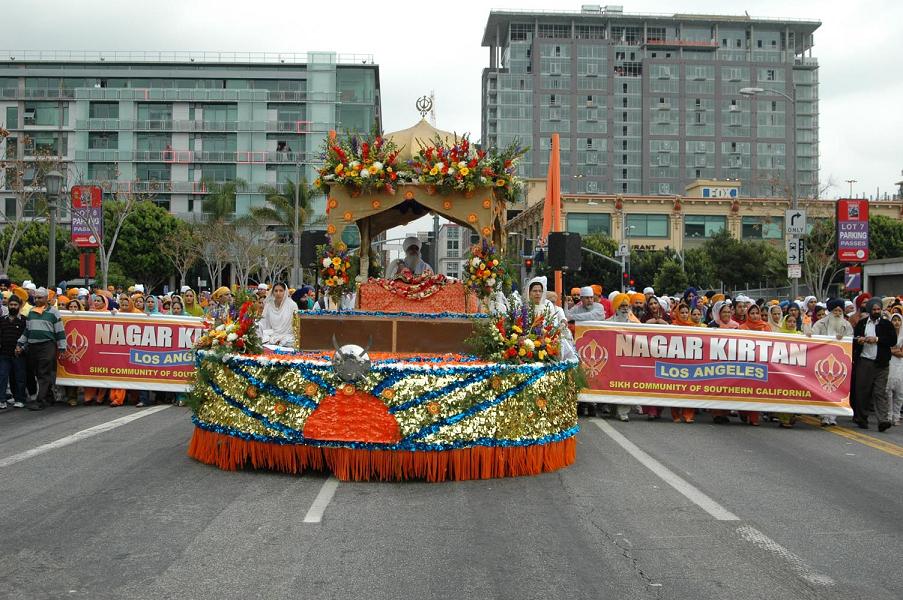|
More
than 10,000 Sikh NRIs attended Baisakhi celebration in Los
Angeles
Vaisakhi is one of the
most important festivals in the Sikh calendar.
Los Angles, April 10, 2007
NRIpress
Sam Sidhu/Manjinder Sagoo
More than 10,000 NRI (non-resident Indians) sikhs from all
over the Southern California State attended Baisakhi celebration
in Los Angeles, marking the Punjabi new year and the start
of the harvest season. The celebration took place Sunday,
April 08, at the Los Angeles Convention Center from 7:30 p.m.
till evening. Nagar Kirtan include devotional music and a
colourful parade featuring 15 decorative floats through downtown
Los Angeles.
Nagar Kirtan, meaning, ‘town and songs of praise’
describes the street processions which form an important part
of the Vaisakhi celebrations. The holy book of the Sikhs,
'Granth Sahib' was taken in a procession, led by the 'Panj
Pyaras' (five senior Sikhs) who are symbolic of the original
leaders.

This is the single largest annual Punjabi event in Los Angles
area that shows cases the Punjabi performing arts and promotes
talent amongst the next generation of the local community.
The generosity of the community can be seen with people giving
free food along the streets, sharing, helping each other,
singing and walking in the parade. Families get together wearing
traditional clothes from far and wide. Businesses and other
community organizations are commonly seen sharing and giving
at their booths or on floats.
The Vaisakhi celebration in Los Angeles was
organized with the coordiation of 17 Sikh organizations- mostly
Gurdwaras of Southern California
Vaisakhi Day is of paramount importance for the Sikhs, as
it was on this day Guru Gobind Singh - the Tenth Guru of the
Sikhs sought to eliminate social discriminations with the
establishment of the universal caste Khalsa Panth.
Baisakhi or Vaisakhi Festival is celebrated as the Sikh New
Year and the founding of the Khalsa Panth. History of Baisakhi
traces its origin from the Baisakhi Day celebrations of 1699
organized by the Tenth Sikh Guru, Guru Gobind Singh to form
Khalsa - Brotherhood of Saint Soldiers to fight against tyranny
and oppression.
Baisakhi is one of the most popular festivals celebrated
in the vibrant state of Punjab to mark the harvest of Rabi
crops. Baisakhi usually falls on April 13, and on April 14
once every thirty-six years. Baisakhi is one of the festivals
where huge amount of cooking with authentic recipes and eating
takes place.
On this memorable Baisakhi day (March,30 of A.D.1699)
, Guru Gobind Singh Sahib called a big meeting at
Kesgarh Sahib near the City of Anandpur Sahib. Between fifty
to eighty thousand Sikhs attended this meeting. When all were
expecting to hear words of comfort and consolation from the
lips of their Guru, they were perturbed to see him with a
drawn sword in his hand and cried ' Is there anyone here who
would lay down his life for Dharam?' There was a big silence,
but the Guru went on repeating his demand. At the third call
Daya Ram, a Khatri of Lahore, rose from his seat and offered
himself. The Guru took him into an adjoining enclosure....(and
soon after) came out with the (blood) dripping....(sword in
hand) and flourshing it before the gathering, asked again,
'Is there any other Sikh here who will offer himself as a
sacrifice(for the cause of dharma)? At this Daram Das, a Jat
of Delhi (Haryana side) came forward and was taken into the
enclosure....(The Guru again came out with the blood-stained
sword, and made his previous demand). In the same way three
other men stood up, one after another, and offered themselves
for the sacrifice. One was Mohkam Chand, a washerman of Dwarka
(Gujarat State); another was Himmat, a cook of Jagannath (Orissa
State); and the third was Sahib Chand, a barber of Bidar (Karnataka
State). The Guru, after dressing the five in handsome clothes,
brought them from the assembly.
These five men were called Panj Piara or 'Beloved Five' by
the Guru. The Guru blessed them with a Pahul ceremony. In
an iron vessel, the Guru stirred with a sword called Khanda
Sahib, the batasha that his wife, Mata Sundari Ji had put
into water. The congregation recited verses from scriptures
as the Guru performed the sacred ceremony. The water was now
considered the sacred nectar of immortality called amrit.
It was first given to the five volunteers, then drunk by the
guru and later distributed amongst the crowd. With this ceremony,
all those present, irrespective of caste or creed, became
members of the Khalsa Pantha (the Order of the Pure Ones).
With the creation of Khalsa, the Khalsa created history and
since the birth of Khalsa, the history of Punjab has been
the history of Sikhs. Baisakhi played a significant role in
this regard. In 1762, Ahmed Shah Abdali, with the sole purpose
to destroy the entire Sikh nation, declared 'Jehad'(holy-war)
against the Sikhs and all the Muslims of the Punjab rallied
under this slogan. The Sikhs were surrounded near the village
Kup in Ludhiana District. Chronicles mention that about twenty
thousand Sikhs were martyred in a single day. This event is
known in the history of the Sikhs as "Ghallughara"
(Bloody Carnage). After this, Ahmed Shah Abdali thought that
he had crushed the entire Sikh nation, but was greatly disillusioned
when after a few months heard that the Sikhs in large number
are celebrating Baisakhi at Amritsar. In due course of time
Baisakhi reminds every Sikh of his cultural and religious
heritage. On Baisakhi day all the Sikhs used to assemble at
Amritsar and decide their problems relating to politics and
religion. This convention still goes on.
The celebrations of Baisakhi are similar to the three-day
schedule of the the celebrations of other Gurpurabs.

|